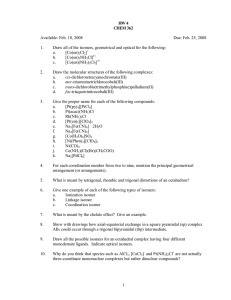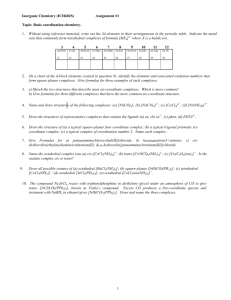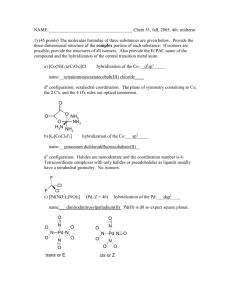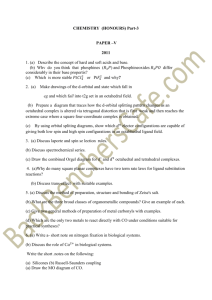Exercises for Advanced Inorganic Chemistry, Part Coordination Chemistry 1.
advertisement
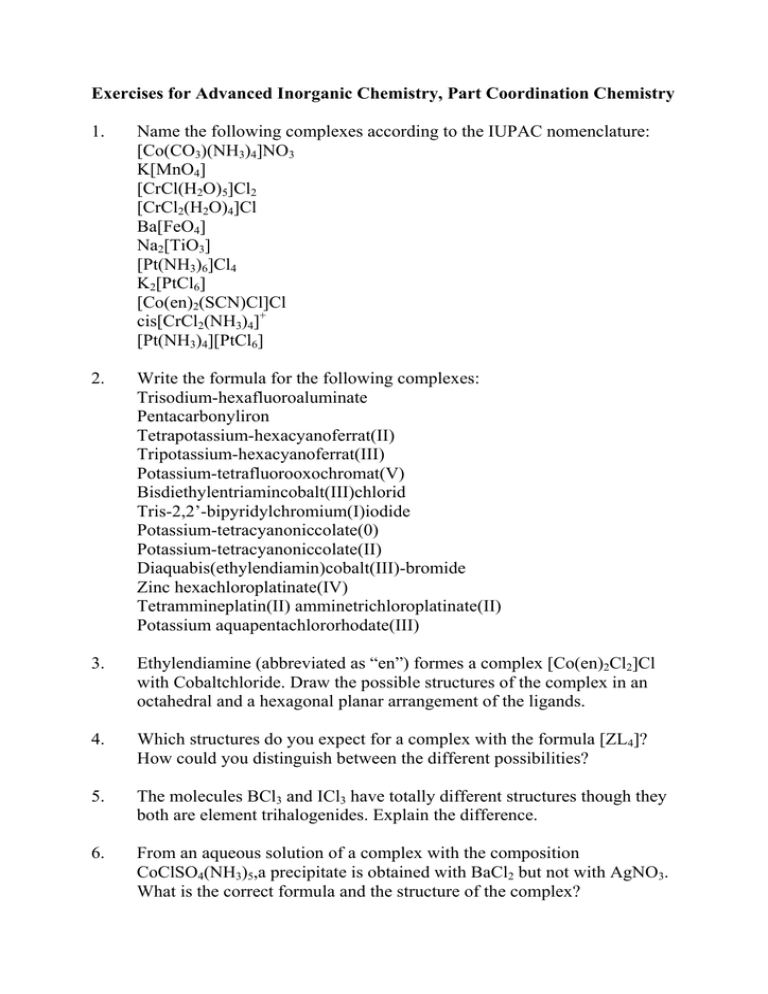
Exercises for Advanced Inorganic Chemistry, Part Coordination Chemistry 1. Name the following complexes according to the IUPAC nomenclature: [Co(CO3)(NH3)4]NO3 K[MnO4] [CrCl(H2O)5]Cl2 [CrCl2(H2O)4]Cl Ba[FeO4] Na2[TiO3] [Pt(NH3)6]Cl4 K2[PtCl6] [Co(en)2(SCN)Cl]Cl cis[CrCl2(NH3)4]+ [Pt(NH3)4][PtCl6] 2. Write the formula for the following complexes: Trisodium-hexafluoroaluminate Pentacarbonyliron Tetrapotassium-hexacyanoferrat(II) Tripotassium-hexacyanoferrat(III) Potassium-tetrafluorooxochromat(V) Bisdiethylentriamincobalt(III)chlorid Tris-2,2’-bipyridylchromium(I)iodide Potassium-tetracyanoniccolate(0) Potassium-tetracyanoniccolate(II) Diaquabis(ethylendiamin)cobalt(III)-bromide Zinc hexachloroplatinate(IV) Tetrammineplatin(II) amminetrichloroplatinate(II) Potassium aquapentachlororhodate(III) 3. Ethylendiamine (abbreviated as “en”) formes a complex [Co(en)2Cl2]Cl with Cobaltchloride. Draw the possible structures of the complex in an octahedral and a hexagonal planar arrangement of the ligands. 4. Which structures do you expect for a complex with the formula [ZL4]? How could you distinguish between the different possibilities? 5. The molecules BCl3 and ICl3 have totally different structures though they both are element trihalogenides. Explain the difference. 6. From an aqueous solution of a complex with the composition CoClSO4(NH3)5,a precipitate is obtained with BaCl2 but not with AgNO3. What is the correct formula and the structure of the complex? 7. Show the structures of a tetrahedron, a square, an octahedron and a trigonal prism by the method which uses points on the surface of a globe, sketch their stereographic projections and give their symmetry groups. 8. Explain the term “bidentate ligand” and give an example. 9. Define/explain the terms chiral, optical isomers, enantiomers, and diastereomers 10. Which of the complexes [Cr(edta)]-, [Ru(bipy)3]2+, and [PtCl(dien)]+ are chiral? 11. Draw all the possible isomers of octahedral [Ru(NH3)4Cl2], square planar [Ir(PR3)2H(CO)], octahedral [CoCl3(OH2)3], and octahedral [CoCl2(en)(NH3)2]+. 12. Why is it not possible to separate and isolate the isomers cis[CuCl2(NH3)4] and trans-[CuCl2(NH3)4]? Is it likely to be possible to separate and isolate the isomers cis-[IrCl2(NH3)4] and trans-[IrCl2(NH3)4]? 13. The commercially available chromium chloride has the composition CrCl3·6H2O. An aqueous solution is green but turns blue and then purple within several hours. Under heating, the solution turns green again. Interpret these observations. 14. Make a sketch of the splitting of the d-orbitals in an octahedral and a tetrahedral ligand field. Name the different orbitals and show how the orbital energies are affected by an elongation of the octahedron along the c-axis. 15. Which coordination geometries are possible for coordination number 4? How do the d-orbitals of the central atom split according to the ligand field theory? 16. Show and explain the main differences between the valence bond theory and the ligand field theory for the description of the bonding in complexes 17. In a [CoF6]3- complex the pairing energy of the electrons is 21000 cm-1 and the ligand field splitting is 13000 cm-1. Which type of a complex do you expect? 18. Make a sketch of cis- and trans-[Co(en)2Cl2]+ and show whether these complexes can exhibit optical isomerism. 19. Which of the ions [Fe(H2O)6]2+ and [Fe(CN)6]4- build a low spin complex? Explain why. 20. Give the electron count for [Fe(CN)6]4+ with respect to the 18e rule. 21. Explain the terms high spin complex and low spin complex with respect to the magnetic properties of coordination compounds and complexes. 22. Discuss the electronic structure and the magnetism of a d8 and a d10 ion in an octahedral and a tetrahedral field. 23. The complex [Ni(CN)4]2- is diamagnetic but [Ni(Cl)4]2- is paramagnetic with two unpaired electrons. Likewise, [Fe(CN)6]3- has only one unpaired electron but [Fe(H2O)6]3+ has five. Explain these observations using a) valence bond theory and b) simple crystal field theory. 24. How does the absorption band in the electronic spectra of complexes shift when the ligands I- is replaced by Cl-, Br- or CN-? 25. Calculate the ligand field stabilization energy for a d1 and a d4system in an octahedral and a tetrahedral field. 26. Which of the following complexes obey the 18 electron rule? [Cu(NH3)4]2+, [Fe(CN)6]4-, [Fe(CN)6]3-, [Cr(NH3)6]3+, [Cr(CO)6], [Fe(CO)5]? 27. There are 5 diastereomers of a complex [PtCl2(NH3)2(NO2)2], one of them having an enantiomer. For each of the achiral isomers, locate the Sn axis to prove that it is not chiral. 28. How many coordination isomers could be formed starting with [Cu(NH3)4][PtCl4]. Write the formula for each isomer. 29. The addition of PEtPh2 to NiBr2 at -78°C in CS2 gives a red, diamagnetic complex with the formula (PEtPh2)2NiBr2 which is converted to a green, paramagnetic complex of the same formula on standing. Which of these complexes is square planar and which is tetrahedral? 30. The spin pairing energy P for Fe2+ is 210 kJ/mole. The ligand field splitting energies of [Fe(H2O)6]2+ and [Fe(CN)6]2+ are 120 and 390 kJ/mole, respectively. Draw a diagram for the splitting of the d-orbitals. Are these complexes in a high spin or a low spin state? 31. Make a sketch of an octahedral complex showing cis/trans isomerism and one showing fac/mer isomerism. 32. Make a sketch of the splitting of the d-orbitals in an octahedral ligand field. Name the different orbitals and show how the orbital energies are affected by an elongation of the octahedron along the c-axis. 33. What quantities are related to the kinetic and the thermodynamic of a chemical reaction. 34. Explain the terms strong, weak, inert, and labile complexes, respectively and name and describe the related figures. 35. For the ligand substitution reaction X-M + Y → X + M-Y sketch the reaction profiles and intermediates for an associative and interchange reaction mechanism. 36. If a substitution process is associative, why may is be difficult to characterize an aqua ion as labile or inert? 37. Explain the term π backbonding by using a metal carbonyl as an example.

